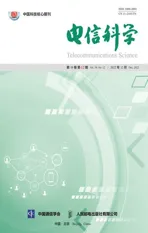一种面向RDSM系统的基于遗传算法优化色散矩阵的方法
2023-01-09章鹏金小萍陈东晓
章鹏,金小萍,陈东晓
一种面向RDSM系统的基于遗传算法优化色散矩阵的方法
章鹏,金小萍,陈东晓
(中国计量大学信息工程学院浙江省电磁波信息技术与计量检测重点实验室,浙江 杭州 310018)
矩形差分空间调制(rectangular differential spatial modulation,RDSM)是一种多天线非相干调制技术,该技术频谱效率高,低功耗且无信道估计开销,特别适用于信道快速变化的车联网、物联网、6G蜂窝网络等未来通信系统。然而发射端的稀疏酉矩形空时色散矩阵(dispersion matrix,DM)的构造问题一直是个难点,而当前使用的随机搜索优化方法具有极高的计算复杂度,对此,提出了一种低复杂度遗传算法(genetic algorithm,GA)。根据秩与行列式标准最大化准则(rank and determinant criterion,RDC)的方法计算适应度值,可避免差分系统中所需的分类讨论。根据星座旋转对称性的特点,降低GA单次迭代的计算复杂度。仿真结果表明,优化得到的DMs(DM set)显著改善了RDSM系统误比特率(bit error rate,BER)性能,对比随机搜索,低复杂度遗传算法有效提高了RDSMS的DMs优化效率,优化DMs所需的计算复杂度约为随机搜索的0.1%。
差分空间调制;索引调制;遗传算法;色散矩阵;星座旋转
0 引言
索引调制[1](index modulation,IM)是近年来提出的一种新型调制技术,在频谱和能量效率以及硬件实现复杂度方面具有突出优势,有望成为6G绿色无线通信的关键候选技术。其中,空间调制[2-4](spatial modulation,SM)是一种在空域的索引调制,具有低功耗和无信道间干扰(inter-channel interference,ICI)的特点,得到了最广泛的研究。差分空间调制[5](differential spatial modulation,DSM)在SM的优势上,实现了非相干检测,克服了信道状态信息(channel state information,CSI)难以获取的问题。该技术特别适用于CSI多变的高速通信环境,在新一代通信系统中拥有巨大的应用前景。
矩形差分空间调制(rectangular differential spatial modulation,RDSM)[6]是基于DSM提出的一种新方案,该技术将DSM方形的色散矩阵(dispersion matrix,DM)拓展成矩形的矩阵,简化了映射关系,并获得了更高的传输速率,实现系统传输速率、发送分集增益、系统复杂度之间的平衡,获得了广泛的研究[6-8]。其中,文献[7]提出了幅度相移键控辅助矩形差分空间调制(amplitude phase shift keying aided RDSM,APSK-RDSM),通过APSK进一步提高了RDSM的频谱效率,但这种方案的发射信号的能量不恒定,在参考块信号传输频率较低的情况下错误传播影响较大;文献[8]提出的空时分组编码矩形差分空间调制(space-time block coded RDSM,STBC-RDSM)方案中,发射信号能量恒定,并利用RDSM简化STBC在DSM中的映射关系,得到的频谱效率均优于DSM同类编码调制方式。
然而,上述对RDSM的研究中,在发射端DM集(dispersion matrix set,DMs)的构造上,都还是采用传统的遍历搜索法,不仅复杂度过高,且性能也不能保证是最佳,这是当前RDSM系统研究的一个瓶颈。而对于DMs的设计,也有相关的研究。在先前设计空时移键控(space-time shift keying,STSK)[9]的DMs时,文献[10]提出了低复杂度搜索算法,利用秩与行列式标准最大化准则[11](rank and determinant criterion,RDC)快速搜索得到DMs。然而这种STSK的DMs并不具有稀疏酉特性。文献[12]利用代数域拓展的方法得到了DSM固定的一组DMs,避免了大量的搜索计算。但这种方法生成的矩阵集虽具有稀疏酉特性,然而矩阵是方形而非矩形的,无法直接应用在RDSM系统中。
针对DMs的优化问题,考虑引入启发式算法。其中,相比粒子群算法、模拟退火算法等其他智能算法,遗传算法(genetic algorithm,GA)具有群体搜索和变异等特性,更适用于高度非线性问题[13-14],特别是DM的矩阵组合优化问题,可以避免不成熟收敛。此外, GA还有可扩展性,易与其他技术相结合。
基于上述背景,提出了一种基于星座旋转对称性遗传算法优化DMs的RDSM系统,分为GA优化的RDSM(GA optimized RDSM,GA-RDSM)方案和GA优化的STBC-RDSM(GA optimized STBC-RDSM,GA-STBC-RDSM)方案。该系统中的GA算法通过种群初始化、交叉、变异、选择以及基于RDC准则的适应度值计算这5个步骤,不断迭代,实现适应度值的稳定攀升,提高了系统的误比特率(bit error rate,BER)性能。在计算适应度时将成对差错概率(pairwise error probability,PEP)公式编码增益项的最小值作为该组种群个体的适应度值。而且根据RDSM的DMs的稀疏酉特性,消除了前一时刻不同的发送矩阵对当前发送矩阵计算适应度值的影响,将问题转变为求取有关信息矩阵差矩阵特征值的问题,简化了适应度计算的过程。仿真结果表明,在保证误比特率性能不变的条件下,对比传统的随机搜索,GA具有更快的收敛性,并进一步通过星座符号的旋转对称性降低了系统单次迭代时的计算复杂度。
1 系统模型
1.1 GA优化的RDSM系统方案



RDSM的接收端所采取的最大似然(maximum likelihood,ML)检测方法[4]的计算式为:



图1 GA-RDSM系统发射端模型
1.2 GA优化的STBC编码RDSM系统方案


2 基于GA的DMs的优化方案

2.1 初始化种群

2.2 适应度值的计算策略
RDSM的PEP上界可以表示为[6]:





2.3 交叉操作

2.4 变异操作


2.5 选择操作

算法1 优化DMs的GA方法

3 理论平均误比特率分析
在本节中,对RDSM系统进行了理论平均误比特率(average bit error probability,ABEP)分析,根据文献[15]所提出的经典的ABEP上界计算式如下:

为了简化计算汉明距离的步骤,式(13)可以被表示为:

系统的成对差错概率(pair-wise error probability,PEP)[5]可以表示为:


图3 DMs在GA迭代过程中的适应度值
4 仿真结果与分析



图4 GA不同方式优化DMs的RDSM性能对比


图5 不同非方形差分的空间调制方案性能对比


图6 不同方案下优化DM计算复杂度
5 结束语
本文提出了一种利用GA优化RDSM的DMs的方案,快速得到基于RDC准则下的最优DMs,利用-PSK的旋转对称性的低复杂度GA方法有效降低了计算适应度值的复杂度。对DMs优化的RDSM的系统性能进行了理论分析和模拟仿真,仿真结果表明,GA优化得到的DMs可以改善RDSM系统误比特率性能,利用星座符号的旋转对称性可以有效降低GA的适应度值计算复杂度,且不影响RDSM系统误比特率性能。
[1] 卞李娜, 冯会真, 金小萍, 等. 广义正交码索引调制系统的性能分析[J]. 电信科学, 2022, 38(8): 120-128.
BIAN L N, FENG H Z, JIN X P, et al. Performance analysis of generalized orthogonal code index modulation system[J]. Telecommunications Science, 2022,38(8): 120-128.
[2] MESLEH R Y, HAAS H, SINANOVIC S, et al. Spatial modulation[J]. IEEE Transactions on Vehicular Technology, 2008, 57(4): 2228-2241.
[3] LI Q, WEN M W, DI RENZO M. Single-RF MIMO: from spatial modulation to metasurface-based modulation[J]. IEEE Wireless Communications, 2021, 28(4): 88-95.
[4] VASAVADA Y, JOHN B B. Low complexity optimal and suboptimal detection at spatial modulation MIMO receivers[J]. IEEE Transactions on Vehicular Technology, 2022, 71(4): 3837-3850.
[5] BIAN Y, CHENG X, WEN M, et al. Differential spatial modulation[J]. IEEE Transactions on Vehicular Technology, 2014, 64(7): 3262-3268.
[6] ISHIKAWA N, SUGIURA S. Rectangular differential spatial modulation for open-loop noncoherent massive-MIMO downlink[J]. IEEE Transactions on Wireless Communications, 2017, 16(3): 1908-1920.
[7] LIU Y, HUANG W R, OUYANG Y G. Amplitude phase shift keying aided rectangular differential spatial modulation[C]//Proceedings of 2019 International Applied Computational Electromagnetics Society Symposium - China (ACES). Piscataway: IEEE Press, 2019: 1-2.
[8] WU C W, XIAO Y, XIAO L X, et al. Space-time block coded rectangular differential spatial modulation: system design and performance analysis[J]. IEEE Transactions on Communications, 2019, 67(9): 6586-6597.
[9] 金小萍, 刘家瑜, 蒋晨, 等. 基于改进遗传算法的 STSK 系统色散矩阵和 3D 星座的联合优化[J]. 电信科学, 2021, 37(9): 86-94.
JIN X P, LIU J Y, JIANG C, et al. Joint optimization of dispersion matrix and 3D constellation for STSK system based on improved genetic algorithm[J]. Telecommunications Science, 2021, 37(9): 86-94.
[10] SUGIURA S. Dispersion matrix optimization for space-time shift keying[J]. IEEE Communications Letters, 2011, 15(11): 1152-1155.
[11] HANZO L, ALAMRI O, EL-HAJJAR M, et al. Near-capacity multi-functional MIMO systems: sphere-packing, iterative detection and cooperation[M]. Hoboken: John Wiley & Sons, 2009.
[12] RAJASHEKAR R, ISHIKAWA N, SUGIURA S, et al. Full-diversity dispersion matrices from algebraic field extensions for differential spatial modulation[J]. IEEE Transactions on Vehicular Technology, 2016, 66(1): 385-394.
[13] HOLLAND J H. Adaptation in natural and artificial systems: an introductory analysis with applications to biology, control, and artificial intelligence[M]. Cambridge: MIT press, 1992.
[14] ASHKZARI A, AZIZI A. Introducing genetic algorithm as an intelligent optimization technique[J]. Applied Mechanics and Materials, 2014, 568/569/570: 793-797.
[15] XIAO L X, DA CHEN, HEMADEH I A, et al. Graph theory assisted bit-to-index-combination gray coding for generalized index modulation[J]. IEEE Transactions on Wireless Communications, 2020, 19(12): 8232-8245.
[16] JOSE D, SAMEER S M. Differential transmission schemes for generalized spatial modulation[J]. IEEE Transactions on Vehicular Technology, 2021, 70(12): 12640-12650.
A genetic algorithm based method of optimizing dispersion matrix for RDSM system
ZHANG Peng, JIN Xiaoping, CHEN Dongxiao
Key Laboratory of Electromagnetic Wave Information Technology and Metrology of Zhejiang Province, College of Information Engineering, China Jiliang University,Hangzhou 310018, China
Rectangular differential spatial modulation (RDSM) is a multi-antenna incoherent modulation technology with high spectral efficiency, low power consumption, and zero-overhead for channel estimation. RDSM is especially suitable for 6G communication systems, such as fast-moving Internet of vehicles, Internet of things, cellular networks, etc. However, the construction of the sparse rectangular unitary space-time dispersion matrix (DM) at transmitter is a problem. The proposed Genetic algorithm (GA) will result in less computational complexity than the currently used random research. The fitness of GA was calculated by the rank and determinant criterion (RDC) method to avoid discussions in differential system. Due to characteristics of constellation symbols of RDSM, the proposed method reduced the computational complexity during each single iteration in GA. The simulation results show that the optimized DMS can significantly improve the bit error rate (BER) performance of the RDSM system. Compared with random search, the low-complexity GA effectively improves the DMS optimization efficiency of RDSM. The computational complexity required for optimizing DMS is about 0.1% of random search optimization method.
differential spatial modulation, index modulation, genetic algorithm, dispersion matrix, constellation rotation
TN929.5
A
10.11959/j.issn.1000-0801.2022291
2022-04-17;
2022-11-10
陈东晓,chendx@cjlu.edu.cn
国家级大学生创新创业训练计划资助项目(No.202110356016);浙江省自然科学基金资助项目(No.LY17F010012);浙江省教育厅研究资助项目(No.Y201840047)

章鹏(1999-),男,中国计量大学信息工程学院硕士生,主要研究方向为索引调制技术、智能反射表面辅助雷达通信技术、通信感知一体化等。
金小萍(1978-),女,中国计量大学信息工程学院副教授,主要从事电子信息与通信专业的教学与科研工作,主要研究方向为MIMO系统与协作通信系统中检测技术、空间调制系统信号架构和检测技术等。

陈东晓(1976-),男,中国计量大学信息工程学院讲师,主要研究方向为无线通信研究、嵌入式系统开发。
s: Project of Innovation and Entrepreneurship Training for National Undergraduates (No.202110356016), The Natural Science Foundation of Zhejiang Province (No.LY17F010012), The Research Funding Project of Zhejiang Provincial Department of Education (No.Y201840047)
